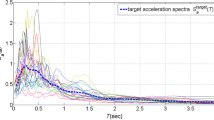Abstract
The endurance time (ET) method is a dynamic analysis in which structures are subjected to intensifying excitations, also known as ET excitation functions (ETEF). The ET method is a tool for structural response prediction. The main advantage of the ET method over conventional approaches is its much lower demand for computational efforts. The concept of acceleration spectra is used in generating existing ETEFs. It is expected that ETEF acceleration spectra increase consistently with time and remain proportional to a target spectrum. Nonlinear unconstrained optimization is commonly used to generate ETEFs. Generating new ETEFs is a complicated time-consuming mathematical problem. If the target acceleration spectrum changes, new ETEFs must be generated. This study intends to modify existing ETEFs to be compatible with a desired acceleration spectrum. This process, called spectral matching, obviates the need for using the complicated generating procedure in simulating new ETEFs. ETEFs spectral matching is introduced in this paper for the first time. A Fourier-based method for ETEFs spectral matching is proposed. This algorithm is then applied in a case study. Results are presented to prove the efficiency of the algorithm.
Similar content being viewed by others
References
Alembagheri, M and Estekanchi H (2011), “Seismic Analysis of Steel Liquid Storage Tanks by Endurance Time method,” Earthquake Engineering and Engineering Vibration, 10(3): 591–604. https://doi.org/10.10167/j.tws.2011.08.015.
ASCE (2005), ASCE. Reston, VA.
Atik, L and Abrahamson N (2010), “An Improved Method for Nonstationary Spectral Matching. Earthquake Spectra, 26(3): 601–617. https://doi.org/10.1193/1.3459159.
Basim MC and Estekanchi HE (2015), “Application of Endurance Time Method in Performance-Based Optimum Design of Structures,” Structural Safety, 56: 52–67. https://doi.org/10.1016/j.strusafe.2015.05.005.
BHRC (2005), Iranian Code of Practice for Seismic Resistant Design of Buildings, Standard No. 2800–05, 3rd Edition, Tehran, Iran: Building and Housing Research Center.
Bommer JJ and Acevedo AB (2004), “The Use of Real Earthquake Accelerograms as Input to Dynamic Analysis,” Journal of Earthquake Engineering, 8(Special Issues 1): 43–91. https://doi.org/10.1080/13632460409350521.
Estekanchi HE, Vafai A and Sadeghazar M (2004), “Endurance Time Method for Seismic Analysis and Design of Structures,” Scientia Iranica, 11(4): 361–370.
Estekanchi HE, Valamanesh V and Vafai A (2007), Application of Endurance Time Method in Linear Seismic Analysis,” Engineering Structures, 29(10): 2551–2562. https://doi.org/10.1016/j.engstruct.2007.01.009.
FEMA (2009), Quantification of Building Seismic Performance Factors (FEMA P695 Report). Washington, DC.
Hancock J, Watson-Lamprey J, Abrahamson Na, Bommer JJ, Markatis A, McCoyh E and Mendis R (2006), “An Improved Method of Matching Response Spectra of Recorded Earthquake Ground Motion Using Wavelets,” Journal of Earthquake Engineering, 10(sup001): 67–89. https://doi.org/10.1080/13632460609350629.
Hariri-Ardebili MA, Sattar S and Estekanchi HE (2014), “Performance-Based Seismic Assessment of Steel Frames Using Endurance Time analysis,” Engineering Structures, 69: 216–234. https://doi.org/10.1016/j.engstruct.2014.03.019.
Kaveh A, Kalateh M and Estekanchi HE (2013), “Production of Endurance Time Excitation Function: the CMA Evolution Strategy Approach,” Iranian Journal of Science and Technology, Transaction of Civil Engineering, 37(C): 383–394.
Kaveh A and Mahdavi VR (2012), “Generation of Endurance Time Acceleration Functions Using the Wavelet Transform,” International Journal of Optimization in Civil Engineering, 2(2): 203–219.
Li Shuang, Liu Kun, Liu Xiangyang, Zhai Changhai and Xie Fengwei (2019), “Efficient Structural Seismic Performance Evaluation Method Using Improved Endurance Time Analysis,” Earthquake Engineering and Engineering Vibration, 18(4): 795–809. https://doi.org/10.1007/s11803-019-0485-x.
Mirzaee A and Estekanchi HE (2015), “Performance-Based Seismic Retrofitting of Steel Frames by the Endurance Time Method,” Earthquake Spectra, 31(1): 383–402. https://doi.org/10.1193/081312EQS262M.
Mirzaee A, Estekanchi HE and Vafai A (2012), “Improved Methodology for Endurance Time Analysis: From Time to Seismic Hazard Return Period,” Scientia Iranica, 19(5): 1180–1187. https://doi.org/10.1016/j.scient.2012.06.023.
Naeim F and Lew M (1995), “On the Use of Design Spectrum Compatible Time Histories,” Earthquake Spectm, 11(1): 111–127.
Nozari A and Estekanchi HE (2011), “Optimization of Endurance Time Acceleration Functions for Seismic Assessment of Structures,” International Journal of Optimization in Civil Engineering, 2: 257–277. Retrieved from http://ijoce.iust.ac.ir/files/site1/user_files_5jkw45/admin-A-10-1-15-72bfa80.pdf.
Preumont A (1984), “The Generation of Spectrum Compatible Accelerograms for the Design of Nuclear Power Plants,” Earthquake Engineering & Structural Dynamics, 12(4): 481–497. https://doi.org/10.1002/eqe.4290120405.
Rahimi E and Estekanchi HE (2015), “Collapse Assessment of Steel Moment Frames Using Endurance Time Method,” Earthquake Engineering and Engineering Vibration, 14(2): 347–360. https://doi.org/10.1007/s11803-015-0027-0.
Riahi HT and Estekanchi HE (2010), “Seismic Assessment of Steel Frames with the Endurance Time Method,” Journal of Constructional Steel Research, 66(6): 780–792. https://doi.org/10.1016/j.jcsr.2009.12.001.
Rizzo P, Shaw D and Jarecki S (1975), “Development of Real/Synthetic Time Histories to Match Smooth Design Spectra,” Nuclear Engineering and Design, 32:148–155.
Silva W and Lee K (1987), “WES RASCAL Code for Synthesizing Earthquake Ground Motions, State-of-the Art for Assessing Earthquake Hazards in the United Stated,” Report 24, Miscellaneous Paper S-73-1, US Army Corps of Engineers, Vicksburg, Mississippi.
Tafakori E, Pourzeynali S and Estekanchi HE (2017), “Probabilistic Seismic Loss Estimation via Endurance Time Method,” Earthquake Engineering and Engineering Vibration, 16(1): 233–245.
Vamvatsikos D and Cornell CA (2002), “Incremental Dynamic Analysis, Earthquake Engineering and Structural Dynamics, 31(3): 491–514. https://doi.org/10.1002/eqe.141.
Vamvatsikos D and Cornell CA (2006), “Direct Estimation of the Seismic Demand and Capacity of Oscillators with Multi-Linear Static Pushovers through IDA,” (April 2004), 1–20.
Author information
Authors and Affiliations
Corresponding author
Rights and permissions
About this article
Cite this article
Mashayekhi, M., Estekanchi, H.E. & Vafai, H. A method for matching response spectra of endurance time excitations via the Fourier transform. Earthq. Eng. Eng. Vib. 19, 637–648 (2020). https://doi.org/10.1007/s11803-020-0586-6
Received:
Accepted:
Published:
Issue Date:
DOI: https://doi.org/10.1007/s11803-020-0586-6




